The philosophy of the sublime was first manifested in art through 19th century Romantic painters’ vast and awe-inspiring landscapes that emphasized mankind’s diminutiveness in the face of God’s treacherously beautiful creation. It was updated in the mid-20th century to include the “abstract sublime,” a phrase coined by Robert Rosenblum to describe the capacious canvases of Barnett Newman, Clyfford Still, and their Abstract Expressionist peers who sought to inspire the same spiritual solemnity in viewers through dramatic interplays of color, line and form. Now we can add several more variations on this theme—the toxic sublime, the apocalyptic sublime, and the industrial sublime. All of these phrases have been variously used to describe the photographs of David Maisel, whose solo show just wrapped up at Mark Moore Gallery and Edward Burtynsky, who is currently on view at Von Lintel Gallery, just a few blocks away from each other in Culver City. Their large-format unaltered photographs of natural and man-made landscapes seduce and beguile the viewer with their fantastical colors, dizzying perspective and conflation of the natural and aesthetic. But through the realization that many of their scenes depict the ravages of human intervention in the environment, we are forced to acknowledge that visual pleasure comes at a tremendous cost.
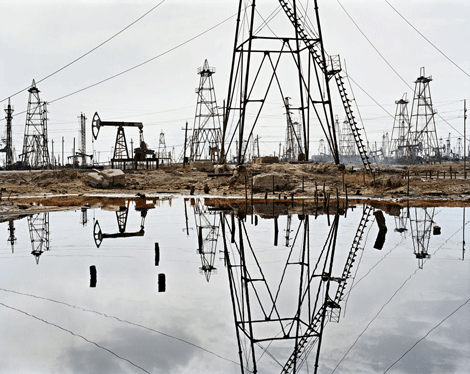
Edward Burtynsky, SOCAR Oil Fields #3, Baku, Azerbaijan, 2006
C-print 58.75 x 73.75 inches (149.2 x 187.3 cm), Edition of 3, courtesy of Von Lintel Gallery
Burtynsky’s photographs are from his travels to remote and familiar locales: China, Italy, Florida, Iceland, India and more. Several photos depict the tools and products of capitalism and industry: SOCAR Oil Fields #3, Baku, Azerbaijan (2006) features a glassy gray pool of water with skeletal oil wells looming behind them and reflected in the water; these are reminiscent of Robert Smithson’s “new monuments” in their abandoned industrial grandeur. Xiluodu Dam #3, Yangtze River, Yunnan Province, China (2012), rendered in exquisitely minute detail and dizzying aerial perspective, is an image of what will be the world’s largest dam once completed—it is a sobering commentary on the lengths to which humans will go to control the natural environment. Stepwell #5, Nagar Kund Baori, Bundi, Rajasthan, India (2010) features one of India’s famed stepwells, wells carved hundreds of feet into the earth which water was accessible only by descending the stairs. During the day they are pilgrimage sites for locals and tourists, but Burtynsky chooses to photograph when empty of human beings, save piles of trash littering the steps.
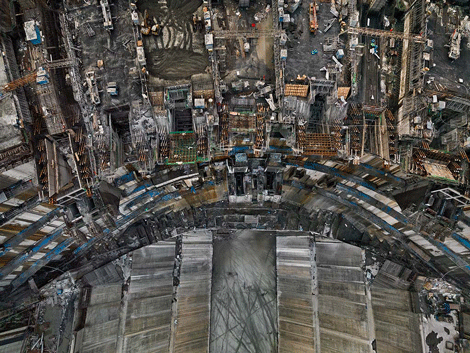
Edward Burtynsky, Xiluodu Dam #3, Yangtze River, Yunnan Province, China, 2012
C-print, 48 x 64 inches (121.9 x 162.6 cm), Edition of 6, courtesy of Von Lintel Gallery.
Indeed, the absence of humans or their reduction to a miniscule size is characteristic of all the works on display. The stunningly gorgeous Canola Fields, Luoping, Yunnan Province, China (2011) is full of vast, manicured fields of vibrant yellow canola plants with softly rounded small hills scattered throughout. Initially it seems like a natural phenomenon until one notices the presence of a very tiny farmer in the foreground, reminding us that these fields were planted by humans and exist for human consumption.
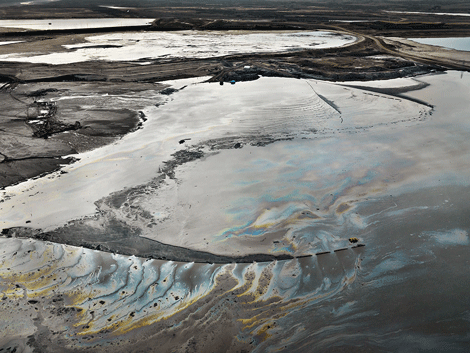
Edward Burtynsky, Alberta Oil Sands #14, Fort McMurray, Alberta, Canada, 2007, C-print
48 x 64 inches (121.9 x 162.6 cm), Edition of 6, courtesy of Von Lintel Gallery.
Many of Burtynsky’s works would not be immediately recognizable as photography without the aid of captions or a very close-up analysis. Through his choice of subject and the framing of the work he often creates images akin to abstract paintings—hence the appropriateness of the label “toxic sublime.” Two works featuring the diagonally sloping rice terraces of the Western Yunnan Province in China in shades of blues, greens and burnished golds at a distance resemble the thick, frenetic brushstrokes of van Gogh. Alberta Oil Sands #14, Fort McMurray, Alberta, Canada (2007) and Phosphor Tailings Pond #2, Polk County, Florida, USA (2012) contains shimmering, surreal billows of milky color permeating the landscape, with the dreamy effect, of course accomplished by untold amounts of pollution. Markafljót River #1, Erosion Control, Iceland (2012) features a wide swath of deep blue-gray color covering two-thirds of the canvas, with unearthly yellow and blue streaking through it. The title reveals what the viewer is looking at, but without the textual aid the work appears completely abstract.
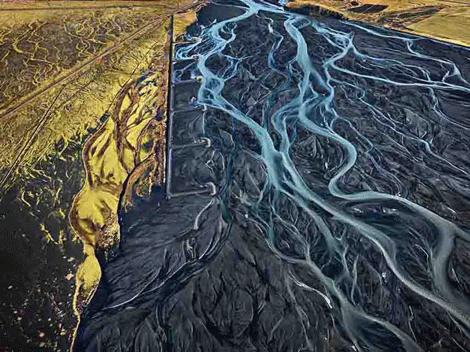
Edward Burtynsky, Markarfljót River #1, Erosion Control, Iceland, 2012
C-print, 60 x 80 inches (152.4 x 203.2 cm), Edition of 3, courtesy of Von Lintel Gallery.
Maisel’s work, all from his 2013 series “The Fall,” in which he photographed the topography between Toledo and Madrid, is similarly abstract, devoid of human beings, and a potent commentary on how we have shaped and molded the land in order to reap its natural resources and sustain our own population with little regard to the environmental impact. The abandoned construction sites, excavation zones, and fields are muted in color —ashy gray and parched brown—and forceful in their assertion through rigid geometries and delineations that the land has been irrevocably altered. The Fall (Borox 2) is a cluster of square-like shapes interlocked with each other, resembling Sean Scully and Hans Hofmann works denuded of color. The three Vicalvaro pieces—depicting abandoned landscapes once slated for construction before the global crash of 2008—are minimalist grids of squares and lines, closer to something from science fiction or a bombed-out warzone than places for human habitation. Maisel’s Borox pieces are like Burtynsky’s phosphor and oil field works in that their capturing of the scraping and shaping of the earth resembles the strokes of a paintbrush and are thus deceptively beautiful.
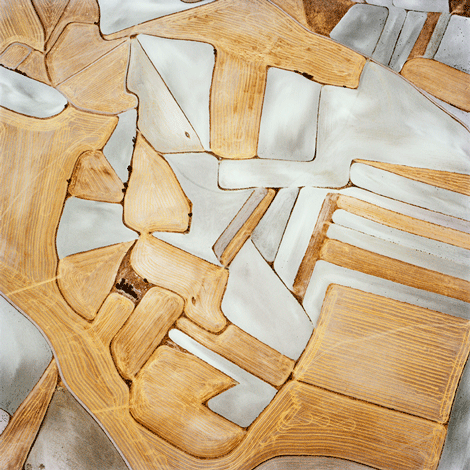
David Maisel, The Fall (Borox 2), 2013 / archival pigment print / 48 x 48 inches / Edition of 6 + 2AP / Courtesy of Mark Moore Gallery

David Maisel, The Fall (Vicalvaro 3), 2013 / archival pigment print / 48 x 48 inches / Edition of 6 + 2AP / Courtesy of Mark Moore Gallery
Both photographers seek to document the ways in which humans have intervened in the environment, but their aims and methods are not wholly journalistic; rather, they utilize the vocabulary of painting and fine art photography, occupying a more ambiguous moral position. Burtynsky has said, “I think rather than present [my work] as a polemic between right and wrong, I like the open-ended nature that allows these photos to become discussion points,” and Maisel’s been quoted saying, “Politics and environment enter into it, but I’m primarily a visual artist, and I’m not making these pictures in order to change policy.”
Their ravaged, romantic environments are both inspiring and implicating, which is what makes their work memorable and compelling.
Edward Burtynsky: Nature Transformed
April 25 – June 20, 2015
2685 S. La Cienega Blvd
Los Angeles, CA 90034
David Maisel: The Fall
Mar 26 – May 2, 2015
5790 Washington Blvd.
Culver City, CA 90232





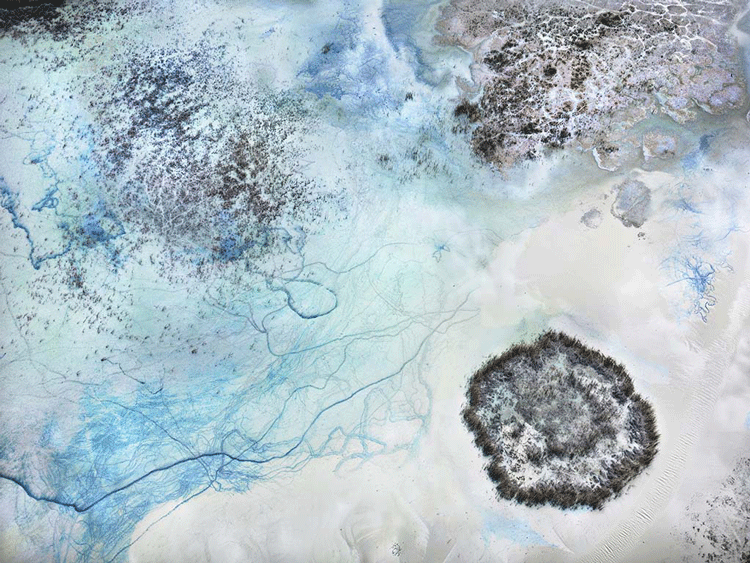













0 Comments